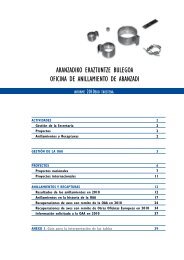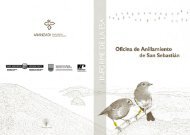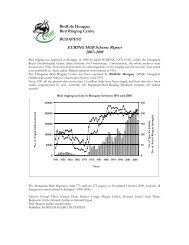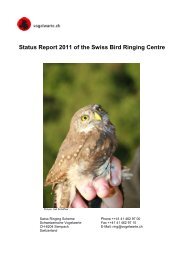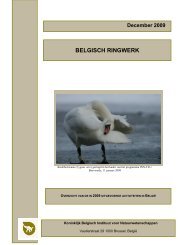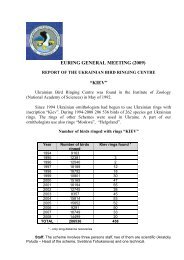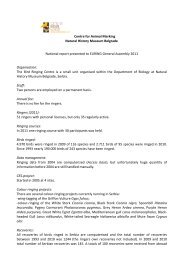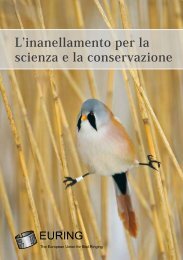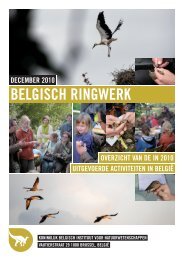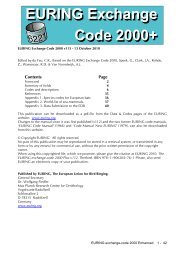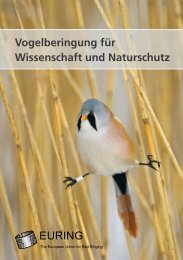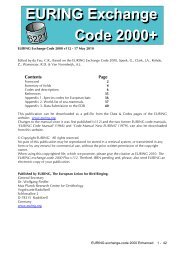The quantitative study of marked individuals in ecology, evolution ...
The quantitative study of marked individuals in ecology, evolution ...
The quantitative study of marked individuals in ecology, evolution ...
You also want an ePaper? Increase the reach of your titles
YUMPU automatically turns print PDFs into web optimized ePapers that Google loves.
EURING 2003 Radolfzell<br />
covery models, whereas female survival estimates were consistent with those from<br />
band recovery models. We suspect the difference between sexes <strong>in</strong> survival estimated<br />
from multistate models was due to higher rates <strong>of</strong> neckband loss <strong>in</strong> males compared<br />
to females, as has been found <strong>in</strong> numerous other studies, and/or higher rates <strong>of</strong><br />
permanent emigration by males from sampled areas. <strong>The</strong> importance <strong>of</strong> violat<strong>in</strong>g model<br />
assumptions depends upon the biological parameter <strong>of</strong> <strong>in</strong>terest, and whether <strong>in</strong>ference<br />
is restricted to the sample population or extended to the entire metapopulation.<br />
10:10 AM - 10:25 AM break<br />
10:25 AM - 10:45 AM<br />
Modell<strong>in</strong>g Dolph<strong>in</strong> Behaviour us<strong>in</strong>g Multi-State Models with Time-Vary<strong>in</strong>g Covariates<br />
S. Brooks & R. K<strong>in</strong>g<br />
Effective management is the key to the protection <strong>of</strong> many endangered species.<br />
Identification <strong>of</strong> the primary factors affect<strong>in</strong>g survival will <strong>of</strong>ten lead to the <strong>in</strong>troduction<br />
<strong>of</strong> strategies to improve survival rates. In this talk, we consider a small population <strong>of</strong><br />
Hector's dolph<strong>in</strong>s located <strong>of</strong> the coast <strong>of</strong> New Zealand and the impact that the establishment<br />
<strong>of</strong> a seasonal sanctuary has on their survival and migration rates. We use a<br />
multi-state model to describe the movement <strong>of</strong> the dolph<strong>in</strong>s around the habitat and<br />
adopt a Bayesian approach us<strong>in</strong>g reversible jump Markov cha<strong>in</strong> Monte to dist<strong>in</strong>guish<br />
between a wide range <strong>of</strong> compet<strong>in</strong>g models. We also exam<strong>in</strong>e the impact <strong>of</strong> the <strong>in</strong>clusion<br />
<strong>of</strong> time-vary<strong>in</strong>g covariates such as catch-effort <strong>in</strong>formation and demonstrate<br />
the added value that these data provide <strong>in</strong> terms <strong>of</strong> both model discrim<strong>in</strong>ation and parameter<br />
estimation. In particular, we f<strong>in</strong>d a whole class <strong>of</strong> models that provide a far<br />
better fit to the data (and therefore better prediction and ultimately better management)<br />
than those adopted <strong>in</strong> previous analyses.<br />
10:45 AM - 11:05 AM<br />
Spatial distribution <strong>of</strong> breed<strong>in</strong>g Pied Flycatchers Ficedula hypoleuca <strong>in</strong> respect to<br />
their natal sites<br />
L. Sokolov, N. Chernetsov, V. Kosarev, D. Leoke, M. Markovets, A. Tsvey, A. Shapoval<br />
Research project on the <strong>study</strong> <strong>of</strong> philopatry and dispersal <strong>of</strong> Pied Flycatchers Ficedula<br />
hypoleuca has been underway on the Courish Spit on the Baltic s<strong>in</strong>ce 1980. A<br />
total <strong>of</strong> 8006 nestl<strong>in</strong>gs were r<strong>in</strong>ged <strong>in</strong> the Russian part <strong>of</strong> the Courish Spit. In subsequent<br />
years, 512 <strong><strong>in</strong>dividuals</strong> (6,4%) were recaptured <strong>in</strong> the whole <strong>study</strong> plot, 300 males<br />
and 212 females. <strong>The</strong> aim <strong>of</strong> this <strong>study</strong> was to test two alternative hypotheses<br />
proposed to expla<strong>in</strong> the distribution <strong>of</strong> breed<strong>in</strong>g Pied Flycatchers <strong>in</strong> respect to their<br />
natal site. <strong>The</strong> breed<strong>in</strong>g area impr<strong>in</strong>t<strong>in</strong>g hypothesis (Löhrl 1959, Berndt & W<strong>in</strong>kel<br />
1979, Sokolov et al. 1984) assumes that <strong>in</strong> spr<strong>in</strong>g, migrants try to return to a relatively<br />
small area, with a radius <strong>of</strong> one to several km. <strong>The</strong> other hypothesis forwarded by Vysotsky<br />
(2001) suggests that all first-year birds and many adults <strong>in</strong> spr<strong>in</strong>g arrive randomly<br />
to an area much larger than the <strong>in</strong>itial <strong>study</strong> area. In 2000, some 800 nestboxes<br />
were added so that their overall number reached 1340 and the length <strong>of</strong> the<br />
<strong>study</strong> plot reached 44 km. To <strong>study</strong> natal dispersal, we compared the observed distribution<br />
<strong>of</strong> natal dispersal distances with the distribution derived from the model assum<strong>in</strong>g<br />
random arrival to the <strong>study</strong> area. Significantly more Pied Flycatchers were recaptured<br />
with<strong>in</strong> several km from the natal site that at larger distance, and this was not<br />
a function <strong>of</strong> the control effort. <strong>The</strong>refore, it is concluded that the home area impr<strong>in</strong>ted<br />
29



